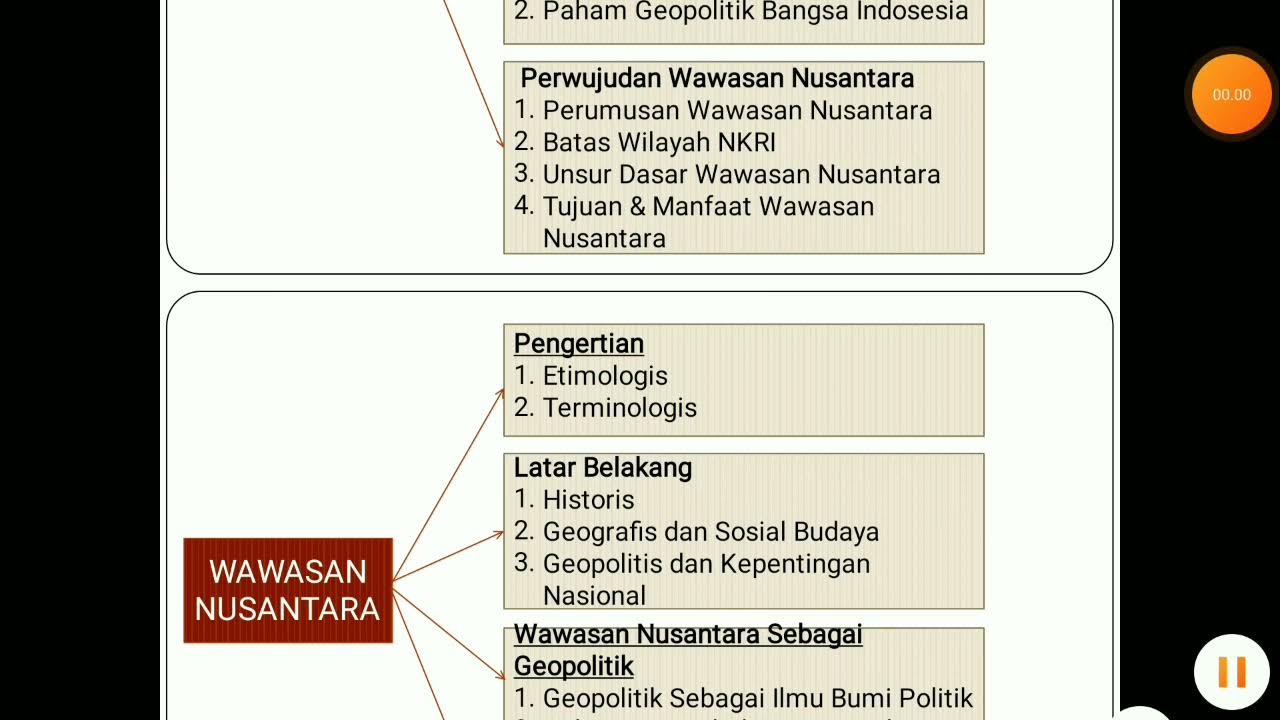Wilayah Negara Kesatuan Republik Indonesia - PPKn Kelas 10
Summary
TLDRThis video explores Indonesia's status as a maritime nation, emphasizing its vast territorial waters and the concept of the archipelagic state as outlined in the 1945 Indonesian Constitution. It discusses Indonesia's geographical characteristics, including its over 17,000 islands, vast ocean territories, and abundant natural resources. The script delves into key aspects like the declaration of the 1957 Djuanda Declaration, the United Nations Convention on the Law of the Sea (UNCLOS), and Indonesia's legal rights over its waters and resources. The nation's sovereignty and control over its wealth are also highlighted, along with its constitutional obligations for managing these assets for the welfare of its people.
Takeaways
- 😀 Indonesia is an archipelago with a vast maritime area, often referred to as a maritime nation.
- 😀 The country’s territorial boundaries and sovereignty are outlined in the 1945 Indonesian Constitution.
- 😀 Indonesia is recognized as a 'Nusantara' nation, with a unified geographical and political territory spanning both Asia and Australia.
- 😀 The country’s maritime zones include territorial seas, an exclusive economic zone (EEZ), and the continental shelf, as established by the United Nations Convention on the Law of the Sea (UNCLOS) in 1982.
- 😀 Indonesia has over 17,000 islands and a sea area that exceeds its land area, emphasizing the importance of maritime resources.
- 😀 The territorial sea extends 12 nautical miles from the baseline, while the EEZ spans 200 nautical miles, granting Indonesia priority rights to exploit marine resources.
- 😀 The continental shelf consists of underwater land extensions of continents, which Indonesia controls over two regions: the Asian and Australian shelves.
- 😀 Indonesia also has airspace sovereignty over its land and sea territory and extraterritorial zones such as embassies in foreign countries.
- 😀 The natural resources in Indonesia’s land, sea, and underground are vast, including forests, agriculture, fauna, and minerals like oil, gas, and precious metals.
- 😀 The 1945 Constitution grants the state control over these resources for the welfare of the people, ensuring the country’s management of these assets for the greater good.
Q & A
What is the significance of Indonesia being a maritime country?
-Indonesia, as an archipelagic state, has vast maritime territories. Its maritime nature is essential for its national identity and international recognition, shaping its political, economic, and cultural dynamics.
What does the Constitution of Indonesia say about its territorial boundaries?
-Article 25A of the 1945 Constitution of Indonesia states that Indonesia is a unitary state comprising a vast archipelago, with its boundaries and rights defined by law.
How is the term 'Nusantara' used in Indonesia's legal framework?
-In the Constitution, 'Nusantara' is used to describe Indonesia's national unity, encompassing its land and maritime territories, ensuring the cohesion of political, legal, cultural, and security aspects of the nation.
What is the Djuanda Declaration and its significance?
-The Djuanda Declaration of 1957 established Indonesia's commitment to the concept of an archipelagic state. This declaration was later acknowledged in international law under the UN Convention on the Law of the Sea (UNCLOS) in 1982.
What are the key components of Indonesia's maritime zones according to UNCLOS?
-UNCLOS defines several maritime zones, including territorial seas (up to 12 nautical miles), exclusive economic zones (up to 200 nautical miles), and the continental shelf, which Indonesia utilizes for resources and jurisdiction.
What is the exclusive economic zone (EEZ), and what rights does Indonesia have within it?
-Indonesia's Exclusive Economic Zone (EEZ) extends 200 nautical miles from its baseline. Within this zone, Indonesia has special rights to explore and exploit marine resources while respecting freedom of navigation.
What is the continental shelf, and how does it relate to Indonesia?
-The continental shelf is the underwater landmass extending from a continent. Indonesia is situated on two continental shelves: the Asian and Australian shelves, which are crucial for its fishing and mineral resources.
What are Indonesia's rights over its airspace?
-Indonesia has sovereignty over the airspace above its land and territorial waters, which is essential for national security and international air traffic control.
What is Indonesia's extraterritorial territory, and where is it located?
-Indonesia's extraterritorial territories include diplomatic missions and embassies in foreign countries. These territories are recognized by international law and are crucial for maintaining diplomatic relations.
How does Indonesia manage its natural resources according to the 1945 Constitution?
-According to Articles 33 and 3 of the 1945 Constitution, Indonesia controls its natural resources, ensuring they are utilized for the greatest benefit of the people. The state has the authority to regulate, manage, and oversee these resources.
Outlines

This section is available to paid users only. Please upgrade to access this part.
Upgrade NowMindmap

This section is available to paid users only. Please upgrade to access this part.
Upgrade NowKeywords

This section is available to paid users only. Please upgrade to access this part.
Upgrade NowHighlights

This section is available to paid users only. Please upgrade to access this part.
Upgrade NowTranscripts

This section is available to paid users only. Please upgrade to access this part.
Upgrade NowBrowse More Related Video

Daring (Wawasan Nusantara Part 2)

PPKn Kelas 10 Bab 2 KETENTUAN UUD NRI TAHUN 1945 DALAM KEHIDUPAN BERBANGSA DAN BERNEGARA |PKn KLS X

Wilayah Negara Kesatuan Republik Indonesia

Wawasan Nusantara

Konsep NKRI Menurut Undang - Undang Dasar Negera Republik Indonesia

Wawasan Nusantara - Pengertian, Unsur, Asas, Tujuan, Manfaat, dan Peran #wawasan #nusantara #sosial
5.0 / 5 (0 votes)